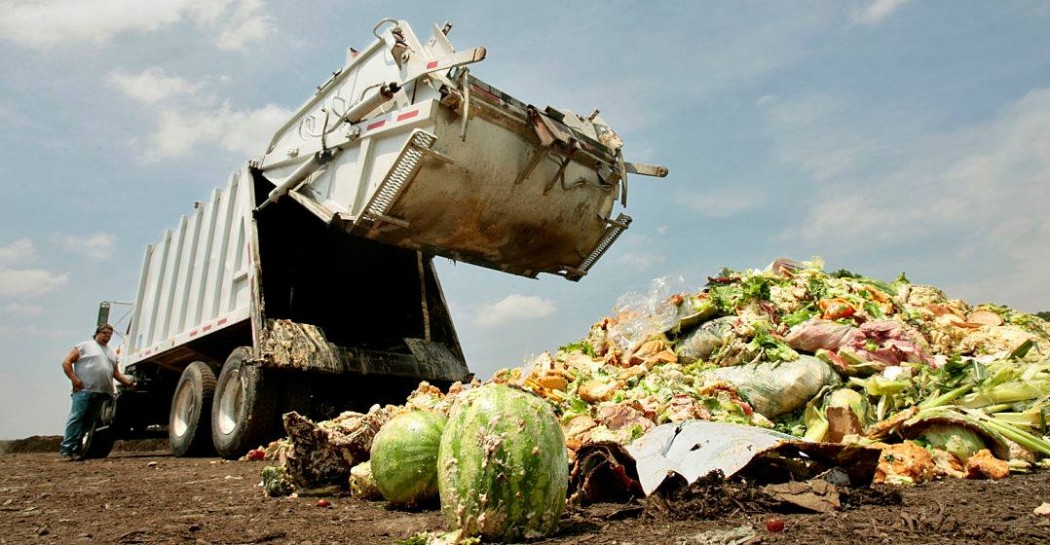There’s always going to be an Ebenezer Scrooge around during the holiday season, and here I am! Hey. How’s it going? Probably not very well for the 795 million people around the world who are starving or suffering from malnutrition. You’ve probably heard that statistic before, but here’s one you might be unfamiliar with: of the 4 billion tonnes of food produced annually, 30% to 50% goes to waste. Canadians alone waste $31 billion worth of food every year, or 2% of our GDP in 2013, or more than the combined GDP of the 29 poorest countries in the world.
So how does this 1.2 to 2 billion tonnes of food end up in a landfill instead of our stomachs? Let’s track a traditional Thanksgiving meal from farm to fork and see where it gets lost on the way.
Pumpkin pie: Unfortunately, this year’s yield of pumpkin wasn’t very good at Mac Farm. Due to colder than normal temperatures and a lack of water during the summer, only half the crop made it through the summer. Farmer MacDonald knows that of the edible pumpkins, fifteen percent won’t meet retailers’ strict physical standards. The sellable pumpkins won’t cover the costs of labour and transportation, so Farmer MacDonald doesn’t even bother harvesting and just plows over them. 10% of Canadian food waste happens on the farm.
Mashed potatoes: Luckily, this year’s potatoes are good enough to be profitable for Mac Farm. Unlike most perishable crops, potatoes can be harvested more than once a year, minimizing a need for storage as they get distributed to grocery stores throughout the year. The potatoes are first packed in crates and transported to retailers, and some bruise during a bumpy journey. Some bruised potatoes can be kept, but their shelf life has been drastically reduced. The ones too unsightly to be sold are salvaged and sent to a storage facility while they wait to be processed into French fries and chips. More potatoes bruise on their way to storage and processing, adding to the amount discarded. 4% of national food waste can be attributed to transportation and distribution problems.
Turkey: Even though people buy whole turkeys at Thanksgiving, when it’s not “in season,” turkey usually comes in the form of processed deli or ground meat. Much of the turkey is discarded at processing, and due to its perishable nature, a portion of the final product is thrown out when it reaches retailers. 20% of Canadian food waste is due to processing.
Stuffing: The grain that managed to make it through harvesting, transportation, and storage usually gets baked into bread and distributed to retailers. Picture this: you’re doing some grocery shopping for Thanksgiving and you need some bread for stuffing. When you check the expiry date, it’s in five days, but it’s still Thursday night. You want your Thanksgiving leftovers to last at least a couple days, so you leave the bread on the shelf and hope they have new loaves when your roommate goes tomorrow. Unbeknownst to you, “best before” dates are rarely regulated, not an indication of food safety, and unnecessarily conservative so the supermarket can avoid being sued. It turns out a lot of people didn’t buy this cycle’s bread, so the supermarket throws it out. Retailers throw out 1.6 million tonnes of food every year.
Brussels sprouts: You’re back at the grocery store the next day because your roommate has a midterm, and Brussels sprouts are on sale. You don’t really like them, but they are traditional Thanksgiving food, and they’re on sale. 12 cents per sprout but $1 for 10, and even though that’s more than enough, your roommate will eat them. Thanksgiving comes and your Brussels sprouts are rather unappetizing, so you put off eating them. By the time you’re done eating the rest of your meal, you’re way too full for Brussels sprouts, so you spoon them off your plate into the garbage. Consumers generate 47% of Canadian food waste.
The real cost of food waste is estimated to be at $107 billion by UN’s Food and Agricultural Organization (FAO). The cumulative cost of resources that go into producing the food, such as energy, water, land, labour, and transport, is two and a half times more than the value of the wasted food itself. Moreover, food thrown out by institutions, such as schools, hospitals, and prisons have not been factored into these estimates due to a lack of reliable data.
Meat in particular takes up a disproportionate amount of resources. If the food used to feed animals were given directly to humans, 2 billion tons more would be available globally and caloric intake would rise by 49%. Rising incomes mean a rising demand for meat, but sustainability will become a more pressing issue, especially with a growing population in the developing world.
Efforts to prevent food waste have begun: France has banned supermarkets from throwing out produce; food banks have partnered with grocery stores in order to receive some of their unsold goods; and there are now campaigns aimed at encouraging people to buy produce that is slightly misshapen. That being said, only 10% of available edible food is being salvaged in North America. Transportation and liability remain an obstacle to getting food where it’s needed most, and in the end, consumers are still the biggest wasters. In Europe and North America, each person wastes on average 95 to 115 kg of food per year.
Hopefully, through more effective movements, those 795 million people will take their rightful place at the world’s dinner table, and wasteful consumers will become Ghosts of Thanksgiving Past.


